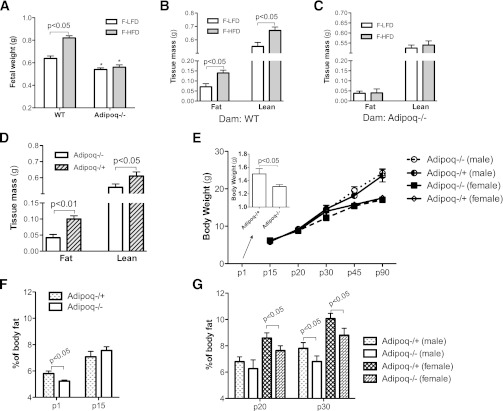FIG. 2.
Adiponectin increased fetal fat tissue mass. Two breeding schemes were used for these studies. Adipoq−/− or WT dams were mated with the same genotype sires (scheme 1, Supplementary Fig. 1A), whereas maternal obesity was induced by HF feeding (A–C). Body weights of e17.5-old fetuses from obese and lean dams were compared (A). Body composition of fetuses from WT (B) or Adipoq−/− (C) obese dams were scanned using magnetic resonance imaging and pooled fetal samples; n = 6. Adipoq−/+ and Adipoq−/− offspring were produced by using scheme 2 (Supplementary Fig. 1B), and all dams were Adipoq−/− (D and E). All offspring and dams were fed with regular chow (D–G). Litter size was adjusted to five to six (E–G). Male and female offspring were separated after weaning (p20). Fetal fat and lean tissue mass were compared between Adipoq−/+ and Adipoq−/− fetuses (D, e17.5; n = 6). Body weight and body composition of Adipoq−/+ and Adipoq−/− offspring were monitored from p1–p90 (E–G; n = 21–24). Data of p1 and p15 mice represent both sexes (F). *P < 0.05 vs. Adipoq−/− offspring. F-HFD, fetus from HF diet–fed dams; F-LFD, fetus of LF diet–fed dams.

